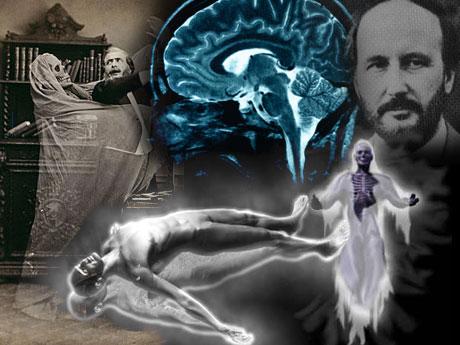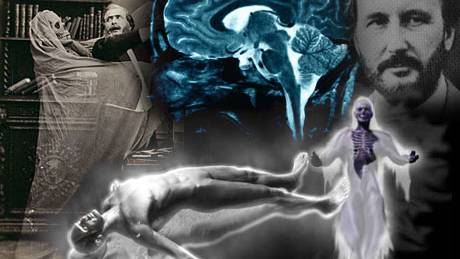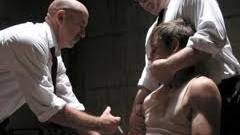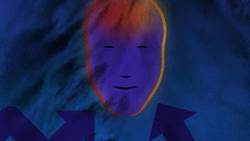Forces of the Unconscious Mind
Source: newdawnmagazine.com

Exploring the Work of Stan Gooch
In the first chapter of his fascinating book The Origins of Psychic Phenomena (1984), the British psychologist Stan Gooch explains that he used to smile when he heard, “for instance, stories of invisible ‘thought forms’ allegedly produced by Tibetan mystics and others.” He then adds: “I no longer smile at such stories. My own feeling, now, is that there may literally be no limit to what can be achieved by the human subjective mind manipulating and actualising itself in the external, objective universe around it.”
According to Gooch, the workings of the unconscious mind – or subjective mind – can shed light on a whole host of paranormal phenomena, including poltergeist disturbances, mediumship, automatic writing, multiple-personality-disorder, succubi and incubi attacks, and even UFO sightings. The list goes on.
Stan Gooch the Medium
Gooch’s involvement with the paranormal began at age 26, when he was working as a school teacher in Coventry, England. Because he was new to the area and had few acquaintances, Gooch decided to enrol in three sets of evening classes, one of which was gymnastics. One evening at gymnastics class, while he was in the changing room, a member of the advanced class, named Peter, struck up a conversation with him. “He eventually told me that his ‘spirit guide’ had instructed him to do so,” explains Gooch. Peter, a spiritualist and medium, invited Gooch to a séance at his parent’s house.
The séance comprised eight to ten people, seated on hardback chairs, facing the medium. Soon after it commenced, Gooch had an experience that was to change the direction of his life. At first he felt light-headed. “And then,” he explains in his book The Paranormal, “it seemed to me that a great wind was rushing through the room. In my ears was the deafening sound of roaring waters. Together these elements seized me and carried me irresistibly forward. As I felt myself swept away I became unconscious.”
When he regained consciousness, Gooch was told that several entities had spoken through him while he was in a trance state. One of the entities identified himself as a cousin of Gooch’s who had been killed in the Second World War. Told by the presiding medium that he was a “strong natural medium” and that he ought to develop his “gift,” Gooch began attending her weekly circle, which consisted entirely of mediumistic individuals.
Sometimes Gooch and the other mediums would channel “higher guides.” Other times they would hold what’s called a “rescue circle,” whereby they would channel the spirits of those who did not realise they were dead, their aim being to help them “move on.” In The Paranormal, Gooch explains what it’s like to be “possessed by one of these lost souls.” It feels, he says, “as if another being ‘materialises’ or arises within one’s body and pervades it… There is a very clear and definite sense of another person within you.”
During one particularly memorable séance, a cave-man materialised in the corner of the room. “It stood half in shadow, watching us, breathing heavily as if nervous,” says Gooch. He later came to suspect that this figure “which so very much impressed and haunted me both then and afterwards” was a Neanderthal. Years later, in 1971, Gooch formulated the hybrid-origin theory, which basically posits that we – Homo sapiens – are a hybrid cross between the two early species of man, Neanderthal and Cro-Magnon. His Total Man trilogy is an exploration of this hypothesis.
On another occasion, soon after the presiding medium said they would experience “a wondrous radiance,” Gooch and the others were illuminated by what appeared to be a bright light shining down from above. Gooch eventually reached the conclusion that this occurrence was a type of collective hallucination, in addition to all the other paranormal manifestation that took place in the séance room. They were, in other words, psychological in nature, not physical. “That is, I do not think that any of the happenings would have registered on a photograph of the scene,” he explains.
In due course, Peter allowed Gooch to have a session with his spirit guide, an alleged American Indian named Grey Hawk. While Peter was channelling Grey Hawk, says Gooch, his face and profile took on the features of a “story-book Indian.” Grey Hawk gave Gooch a long lecture on “the nature of spirit,” which Gooch found moving and poetic, though also empty and unsatisfying. Gooch says he finds many talks by spirit guides, as well as books that have been dictated by them, “a kind of intellectual candy-floss… When you try to chew on these utterances, there is nothing there. The mouth is empty.”
It is because of this reason, as well as numerous others, says Gooch, that “personalities” like Grey Hawk are nothing more than a product of the unconscious minds of the mediums who claim to channel them. “One is that the alleged spirits never tell us anything that is not already known to living persons on this planet – and, almost invariably, known to the bereaved person ‘sitting’ with the medium,” he explains.
More on Mediumship
In The Origins of Psychic Phenomena, Gooch mentions how the author and former Air Force officer Sir Victor Goddard once asked the British medium Ena Twigg to contact one of his friends who had died. Remarkably, Twigg managed to give an accurate description of this individual – his appearance and personality, etc – even though she hadn’t been told anything about him. In a later session, she went into a trance, apparently channelling Goddard’s friend. In a description of this event, Goddard mentions that Twigg adopted his friend’s mannerisms and personal figures of speech, and that he was thoroughly taken aback by what he had witnessed. “It wasn’t so much the information which was conveyed as the manner of its conveying in speech, in action, and in gesture that carried conviction…,” writes Goddard.
Gooch uses this case to support his theory that mediumship has nothing to do with spirits. What is occurring instead, he says, is that the medium is unconsciously “tapping into” the mind of the sitter. “…There is nothing in what the ‘spirits’ narrate that persuades us that anything but a memory of that person is operating…,” he explains.
In his book Afterlife (1985), the British author and paranormal expert Colin Wilson explores, among other things, the subject of mediumship, eventually reaching the conclusion that there are indeed such things as spirits. The “unconscious mind theory,” he says, falls short of explaining a great many number of mediumistic communications, as well as a large number of poltergeist disturbances. Most paranormal investigators, he says, “are finally driven to the conclusion that spirits almost certainly exist. They do this with the utmost reluctance. It would be far more convenient, and far more logically satisfying, if we could explain all the phenomena in terms of the unrecognised powers of the human mind.”
Not surprisingly, Gooch gives the “spirit hypothesis” very little consideration. He does state, however, that it would be arrogant to rule out the possibility that some “spirits” have an independent existence, and are therefore not a product of one’s own mind.
The unconscious mind, says Gooch, for which a better name would be “alternative consciousness,” is far more dynamic and powerful than we assume. It is, in a sense, an entity of its own, possessing its own logic and autonomy, and, when repressed, is capable of expressing itself in very odd and alien ways – mediumship being a perfect example.
In Gooch’s opinion, as mentioned previously, ‘channelled’ information, as a general rule, leaves much to be desired. As an example – and a good one at that – Gooch mentions the numerous ‘Seth’ books that have been written through Jane Roberts. All of these books, says Gooch, “mean absolutely nothing.” Jane Roberts, by the way, who died in 1984, was a successful and prolific author before she became a ‘mouthpiece’ for Seth.
In late-1963, as part of her research for a book on ESP, Roberts, who was then thirty-five, started experimenting with an Ouija board. Her husband, Robert Butts, took part in these activities. Before long, they began to receive coherent messages from a male personality who later identified himself as Seth. Before long, Roberts began to hear Seth’s voice inside her head. She then developed into a medium, regularly going into a trance state in which Seth would allegedly speak through her. Over the years, with Butts acting as stenographer, Seth’s deranged philosophical and spiritual ramblings were written down and compiled in book, after book, after book…
However, some of this material was written automatically, whereby Roberts would enter a trance state and let her hand “take over.” Seth described himself as an “energy personality essence no longer in physical form.” He claimed, moreover, that he existed independently of Robert’s subconscious (or ‘unconscious’, as the two words basically have the same definition).
Hypnosis and the Theories of Thomas Jay Hudson
In the early-1880s, the subject of hypnosis attained a certain degree of scientific acceptance, and was being employed by leading psychologists to investigate the realm of the unconscious. After witnessing a remarkable display of hypnosis, conducted by the famous Professor Carpenter, a Detroit newspaper editor named Thomas Jay Hudson decided to formulate his own theories about such matters, later writing an influential book on the subject called The Law of Psychic Phenomena (1893). (By ‘psychic’ he means psychological.)
The hypnosis presentation conducted by Carpenter, which so impressed Hudson, took place in Washington DC. One of the participants, a college graduate identified only as ‘C’, was placed under hypnosis and made to believe that he was in the presence of Socrate’s spirit, which he, but nobody else, was able to see. He was also told that Socrates would answer any question he desired. C and the imaginary Socrates then began to have a conversation, with C repeating everything ‘Socrates’ said, so that Carpenter and the audience could hear it. Apparently their conversation went on for two hours, and the answers ‘Socrates’ gave were so plausible and impressive that some members of the audience were firmly convinced of his being there in spirit form.
C was then introduced to the ‘spirits’ of far more modern philosophers, and again, the conversations that took place left the audience spellbound. Each ‘philosopher’ he talked to had their own distinct style of speaking. The language they used, moreover, was also distinct, as were the comments they made. It should also be mentioned that the ideas and opinions they expressed were far different to those which C possessed. Had the entire discourse been printed word for word, says Hudson, it would have “former one of the grandest and most coherent systems of spiritual philosophy ever conceived by the brain of man.”
There were, it turns out, a small number of spiritualists in the audience, some of whom believed that the presence of spirits could explain what they had witnessed. It’s fair to assume, however, that some of them began to question this notion when Carpenter managed to invoke the ‘spirit’ of a talking philosophical pig, which proved to be something of an expert on the Hindu doctrine of reincarnation.
In an attempt to explain hypnosis and other phenomena of this nature – including genius, insanity and even the miracles of Jesus – Hudson formulated the theory that man has two minds, the subjective and the objective. The objective mind, which is practical in nature, allows us to function effectively in the real world. It operates, moreover, through the medium of the five senses.
The subjective mind, on the other hand, is non-practical in nature, and allows us to deal with our inner problems. It prefers to use intuition, and is highly suggestible. “It is the seat of the emotions, and the storehouse of memory,” explains Hudson. “It preforms its highest functions when the objective senses are in abeyance. In a word, it is that intelligence which makes itself manifest in a hypnotic subject when he is in a state of somnambulism.”
During hypnosis, says Hudson, the objective mind – the ‘you’ – is put to rest, allowing the subjective mind, which is a “separate and distinct entity,” to take charge of the brain and body. According to Hudson, when in control, the highly intuitive – in fact, psychic – subjective mind is able to perform all sorts of remarkable, almost supernatural, feats. Hudson knew of cases where hypnotised subjects, who had their eyes closed, were able to read a newspaper held by someone on the opposite side of the room. He had also heard stories of people, who, under hypnosis, were able to speak foreign languages they had never consciously learnt, later discovering that they had been exposed to the languages in early childhood, and had therefore managed to ‘absorb’ them unconsciously.
If one were to compare Gooch’s theories with Hudson’s, they would obviously say that the objective mind is the same as the conscious, and the subjective mind is the same as the unconscious.
Automatic Writing
As explained in his book The Paranormal, Gooch not only developed mediumistic powers, he also developed the ability to write automatically. “After only one or two attempts my hand began to write vigorously and fluently,” he explains. To be successful in this endeavour, he says, one must be totally relaxed and in an environment free of distractions, paying as little attention to one’s “writing hand” as possible. “After a few sessions, perhaps even in the first, the hand will begin to twitch occasionally of itself. Marks and scribbles may be made. In time many people can progress to a hand that writes coherently by itself.”
After much experimentation with automatic writing, Gooch reached the conclusion that his unconscious mind was producing the results. The types of ‘personalities’ that expressed themselves on paper, he says, were many and varied. He describes some of their comments as solemn and soulful. Others, he says, were “naughty remarks of the ‘impish spirit’. And occasionally the cursing and filth of the true demon or devil.”
Gooch soon discovered that, simply by using mental commands, he was able to alter the tone and style of the material he wrote automatically. This process, he insists, was purely mental, in that no amount of deliberate, physical force was used. “I could also lead the conversation in any direction I chose,” he explains. “I could easily catch out the communicant by causing him or her to contradict something said earlier.”
In The Origins of Psychic Phenomena, Gooch provides further evidence to suggest that one’s own unconscious mind is able to produce automatic writing. He mentions the work of a physician named Dr. Anita Mühl of the St. Elizabeth’s Hospital in Washington, who used automatic writing as a tool to treat hospitalised neurotics and psychotics. Mühl discovered that the material her patients wrote automatically – which consisted mainly of short poems, short stories, drawings and musical compositions – often contained elements that illuminated the problems they suffered from. She found, moreover, that discussing and exploring this material with her patients was of considerable therapeutic value.
Mühl’s patients wrote in a variety of different ways, some of which were very odd indeed; as she explains in her own words: “The subject may display a sudden facility for using the opposite hand or for using both together and may even produce two personalities at once, each making use of a different hand and each representing a different sex. He may write mirrorwise with either or both hands and he may write backwards correctly and speedily…”
One of Mühl’s patients, a woman “of such refinement and charming manner,” who suffered from various sexual difficulties, produced automatic writing that contained “the most obscene and filthy language.” Analysis of this material revealed that the patient had been repeatedly sexually assaulted as a child, and that this was the cause of her problems. Although she had only the vaguest recollections of these humiliating and distressing incidents, her unconscious mind had recorded it all in great detail.
A Brief Note on the Poltergeist
No article on the paranormal abilities of the unconscious mind would be complete without mentioning the poltergeist. Most experts on the poltergeist agree that these dramatic, frightening and often violent manifestations are created by the unconscious mind of a particular person around whom the disturbances take place. This individual – sometimes called the agent or focus – is often psychologically disturbed in some way. Many well-documented cases exist where the focus was a pubescent child.
According to the parapsychologist Scott Rogo in his book The Poltergeist Experience, poltergeist disturbances occur when an individual creates a “PK-being from his inner guilt, hate and repression, which takes on a life of its own…” This “PK-being,” he says, “grows in force until it completely severs itself from the will or personality that gave it birth.” The disturbances cease, he says, once the PK-being has expended all its energy.
The Cerebellum as the Unconscious
So where in our brains is the unconscious located? After all, the cerebral cortex, the outer layers of the two hemispheres of the cerebrum, is widely considered to be the general, physical location of the conscious mind, as many of the functions it performs are those which take place in a fully awake state of consciousness.
Gooch proposes that the cerebellum – or “little brain” – is the physical seat of the unconscious mind. He points out, for instance, that strong evidence exists to suggest that the cerebellum is directly responsible for the function of dreaming. He also points out that it is the headquarters of the autonomic nervous system, while the cerebrum – the conscious mind – is the headquarters of the central nervous system (CNS). Women, he says, who are generally more psychic than men, have larger cerebella than men, as confirmed by brain imaging techniques.
Exploring the Realm of the Unconscious
The fact that we dream, says Gooch, proves that we inhabit not one universe, but two – the world of the conscious, and the world of the unconscious. The latter of which – the “inner alternative world of the mind” – is open to extensive exploration, he says. Some people, including Gooch, reach it by sustaining a hypnopompic state, remaining in a semi-conscious condition – the one that precedes complete wakefulness (as opposed to the one that precedes sleep, knows as a hypnagogic state).
Gooch says the “inner universe” can take on a variety of different forms, such as that of a town – with streets shops, cafes and people – or that of a beautiful countryside. In this universe, he says, one is able to talk to people, and even have sex. “The sex is not just as good as, but better than that obtained in the real world, because one’s own personal archetypal wishes and fantasies may be, and often are, lived out,” he explains.
Gooch believes that the unconscious mind manifests paranormal phenomena in response to being repressed. In a “balanced” individual, he says, the two minds exist in harmony. But when an imbalance occurs, when the unconscious mind is not given its due, there is an externalisation of latent energies. It is then that we are haunted by creatures and forces from the mysterious universe of our other mind.
Bibliography
Richard S. Broughton, Parapsychology – The Controversial Science (Ballantine Books, US, 1991)
Stan Gooch, The Paranormal (Wildwood House Ltd., UK, London, 1978)
Stan Gooch, The Origins of Psychic Phenomena (Rider & Co, UK, 1984)
Brian Inglis, Trance – A Natural History of Altered States of Mind (Grafton Books, UK, 1989)
D. Scott Rogo, The Poltergeist Experience – Investigations Into Ghostly Phenomena (Penguin Books Ltd., Middlesex, England, 1979)
Colin Wilson, Afterlife (The Leisure Circle Ltd., UK, 1985)
Colin Wilson, Beyond the Occult (Caxton Editions, London, UK, 1988)
Louis Proud is a resident of Melbourne. An aspiring writer, whose interests include Western occultism, parapsychology and ufology, he has written numerous articles on these and other unconventional topics. He can be contacted by e-mail at louisproud2000@yahoo.com.au.
© Copyright New Dawn Magazine, newdawnmagazine.com. Permission granted to freely distribute this article for non-commercial purposes if unedited and copied in full, including this notice.
Article from: http://www.newdawnmagazine.com/Article/
Forces_of_the_Unconscious_Mind.html






















